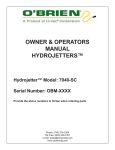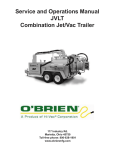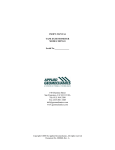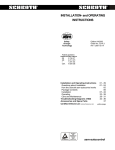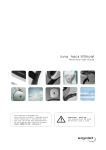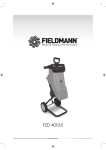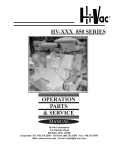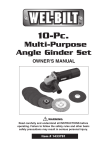Download Operators Manual for 2513-JE Cart Jetter - Hi
Transcript
Operators Manual for 2513-JE Cart Jetter Phone: (740) 374-2306 Toll Free: (800) 638-1901 e-mail: [email protected] www.obrienmfg.com Congratulations We at Hi-Vac Corporation wish to express our appreciation on your purchase of a water-jetting sewer cleaner (jetter). With you in mind, our skilled craftsmen have designed and assembled the finest water-jetting sewer cleaner available. This manual includes operating instructions, maintenance instructions, and instructions for troubleshooting. Your jetter is built for dependability, and will bring you years of service, as long as maintenance is performed regularly and a qualified person operates the jetter. Sincerely, Hi-Vac Corporation History Your new O’Brien water jet unit is the latest model developed in over 40 years of producing sewer-cleaning equipment. Depending on your pump, over 2,000 psi water pressure can be generated. This pressure is directed through the hose to a nozzle, which is propelled into the sewer line by a rearward directed force of water. Just the right amount of water plus pressure is needed to effectively clean the pipe and neither high pressure nor large amounts of water alone will do the job. With just the right combination at your disposal you will find the jet nozzle will carry the weight of the hose into the pipe. With the penetrator installed (we recommend that your cleaning begin with the penetrator nozzle) it should penetrate most blockages of grease, sand, mud etc. that clog the line. Normally, the penetrator nozzle is used to scour the inside of the pipe. The actual cleaning of the pipe is done as the hose is being retracted from the pipe onto the reel. You will note that this brings out the source of the blockage. Little or no cleaning is done while entering the sewer either with the penetrator or other nozzles. Therefore it is very important that when retracting the hose a slow steady speed is used. Many times it is necessary to repeat this slow retracting process to thoroughly clean the pipe. Hi-Vac’s years of experience in developing and using various pressures and flows have not succeeded in being able to cut roots by pressure alone. Although some manufacturers state that extremely high pressure will remove roots, Hi-Vac has not been able to confirm or verify these statements. Instead, Hi-Vac offers the patented original water powered root cutter unit. When any root systems are encountered, we highly recommend the O’Brien Root Cutter machine, which not only cuts any roots in the system but other blockages such as starch and grease build-ups. The Root Cutter also is an aid in indicating broken or caved-in tile pipe or sewers. Before operating the unit, read the enclosed engine and pump manuals carefully and review the safety information in great detail. Warranty Registration Instructions Immediately upon receiving: • Examine the unit for damage. Notify the carrier at once with any claims. • The Warranty/Registration Card is located in the front of your owner’s manual. The consumer must fill out the Warranty/Registration Card and mail back to Hi-Vac Corporation within ten (10) working days. The warranty is provided below. • The Hi-Vac Corporation identification tag contains product identification information which is also provided on the cover sheet inside your Operator’s Manual. Record the required information in the space provide below. This information must be provided when filing a warranty claim or ordering parts. Serial No. ___________________ Model No. ____________________ • RETAIN THIS INFORMATION FOR FURTHER USE • HAVE THIS INFORMATION WHEN FILING A WARRANTY CLAIM OR ORDERING PARTS Warranty Each and every product manufactured by Hi-Vac Corporation is tested carefully prior to shipment to assure a high standard of quality and maximum operating efficiency. The following warranty is operative upon the receipt, by Hi-Vac Corporation, of a properly completed and executed warranty registration card. A. Hi-Vac Corporation warrants that sewer units, equipment, accessories and parts manufactured by HiVac Corporation shall for a period of one (1) year from date of purchase be free from: 1. Defects in material and workmanship. 2. Defects arising from process of manufacturing. 3. Defects in design thereof. B. The foregoing warranty shall not apply to components supplied to Hi-Vac Corporation by other manufacturers and the purchaser is directed to contact said individual manufacturers nearest factory service center for repair or replacement of said components. Hi-Vac Corporation, when necessary, will act as agent to secure adjustment. Purchaser is responsible for labor and freight of any return part/components. C. In case of defects in material or workmanship or defects arising from processes of manufacture or design, such defects must become apparent in the machine, accessory, equipment, or part within (1) year from date of purchase. The extent of Hi-Vac Corporation’s liability under the warranty is limited to the repair of such defects or to the repair or replacement of any part, equipment, or accessory, which is defective in any such respects. D. Hi-Vac Corporation shall, as to each defect, be relieved of all obligations and liability under this warranty if: 1. The product is operated with any accessory, equipment, or part not specifically approved by HiVac Corporation and not manufactured by Hi-Vac Corporation unless purchaser furnishes reasonable evidence that such installation was not the case of the defect. 2. The product is not operated or maintained in accordance with Hi-Vac Corporation’s operation manual furnished with said equipment. 3. The product was modified, altered, or repaired without the approval of Hi-Vac Corporation. 4. The purchaser does not, within the applicable time period set forth in paragraphs A and C above; notify Hi-Vac Corporation of said defect. Disassembly of the product to correct the defect, removal of the defective accessory, new part(s) and reassembly of the product shall be at the purchaser’s expense. 5. Purchaser does not submit reasonable proof that the defect is due to a material embraced within Hi-Vac Corporation’s warranty hereunder. Liability under this warranty is limited to parts and is furthermore limited to the replacement or repair of said parts returned, freight prepaid, to Hi-Vac Corporation. Only parts deemed defective due to workmanship or a related defect will be warranted. A Return Goods Authorization (RGA) number and completed warranty evaluation form are required prior to the return of any part(s) to Hi-Vac Corporation. Under no circumstances is loss of time, revenue, or consequential damages covered under this warranty. Any part(s) returned without proper pre-authorization will be returned/refused. Technical Service will supply the RGA. Please phone Technical Service @ 800.752.2400 to obtain the proper authorization or with any other service related question. Maintenance This section covers maintenance procedures not covered by the manufacturers’ instruction manuals. Please follow the manufacturers’ instructions for engine, pump and power take-off maintenance. Fluid Levels 1. Water Pump – Oil Check tank fill daily Fill with 30 W SEA oil 2. Engine Oil Check tank fill daily Fill with 10W-30 oil Jetter Operation Safety Precautions ÌWARNING Read manual and supplemental(s) before operating water jetter. Read and become familiar with all safety precautions, pre-operation notes and details, operating instructions and manual operating instructions before operating your jetter. ÌWARNING Inspect jetter before operation. Do not operate jetter if you suspect damage, wear or any abnormal condition. ÌWARNING Keep operator and bystanders clear of area in which high pressure hose operates. ÌWARNING Do not overload or abuse water jetter unit. ÌWARNING Do not operate jetter while on medications, narcotics, or while intoxicated. Always wear protective clothing and eye protection when operating equipment. ÌWARNING Do not allow children to operate equipment. ÌWARNING This equipment can be hazardous to the operator’s safety, and only authorized personnel who have read and understand the installation and operating manual should be permitted to operate this unit. ÌWARNING Do not allow equipment to run unattended. ÌWARNING This unit may conduct static electricity through the discharge nozzle, and is not designed for cleaning applications using combustible liquids, materials, or flammable gases. To do so could result in severe or fatal injury. ÌWARNING Do not use any type of insecticide, toxic chemicals, or heat-activated chemicals that produce toxic fumes or explosive materials in the soap solution system of this equipment. Use only those detergents proven safe for human contact. Failure to do so could result in severe or fatal injury. ÌWARNING Do not keep gun trigger open by mechanical means when using washdown gun. ÌWARNING Do Not stand or allow other personnel to stand in front of the cleaning gun nozzle and avoid contact with hot water discharge if connected to hot water source. To do so could result in severe bodily injury. ÌWARNING Bleed off all pressure prior to removal of nozzles, hoses, or drain plugs. ÌWARNING Position and secure hose and reel before transporting jetter. ÌWARNING Accidental activation of control switch (es) may cause unintended operation(s). ÌWARNING Maintenance and lubrication procedures must be performed as specified in this manual by qualified (authorized) service personnel. ÌWARNING Replace missing, worn, or illegible decals. ÌWARNING Keep owner’s/service manual with jetter at all times. ÌWARNING Never modify (alter) a Hi-Vac Corporation water Jetter. ÌWARNING Do not use accessory devices not authorized by Hi-Vac Corporation. ÌWARNING Do not remove any guards or covers. ÌWARNING Failure to follow these safety precautions may result in serious bodily and/or property damage. Operation 1. Check the engine oil and hydraulic oil levels. 2. Engine and pump maintenance schedules must be followed. 3. Connect the water line to the cart jetter. 4. Follow engine manufacturer’s instructions for starting engine. 5. Engine should be started and warmed up for 3 to 5 minutes before applying any load. 6. The unit should be positioned as close to the cleaning location as possible. 7. Normal cleaning is started by using the penetrator nozzle, which should be attached at this time. 8. Unwind hose from the reel by pulling the hose off of the reel. Care should be taken not to damage the hose by keeping it clear of the manhole sides. 9. The point of the hose nozzle should be pointed upstream into the pipe rather than downstream. 10. Make sure water control valve lever is in correct position for cleaning. NOTE: The valve has two marked positions. One is marked High Pressure to Hose Reel, and the other is marked Re-Circulate, Wash down Gun (this position is for operating the washdown gun). 11. With the hose unreeled and pointed into the sewer or pipe, engage the engine by putting the clutch handle to the ON position. The nozzle will now start to carry itself into the sewer line and penetration will begin. The correct method of cleaning is to extend the hose into the line and gradually and slowly retract it. During the retraction you will note that cleaning or flushing takes place. 12. Adjust engine throttle by using the vernier throttle control unit (desired pressure is shown on the pressure gauge). More throttles produces more pressure which gives greater effort to drive the hose and nozzle into the line. Pressure is normally set at 2,500psi. 13. Unreel the hose, as needed allowing the nozzle to go further into the line. Short distances into the line are recommended on the first pass with slow retraction to flush the blockage of the line. 14. In large lines, or in lines with several clogs, repeated passages may be necessary to insure that the line is cleaned to your satisfaction. 15. When the pipe or line is cleaned, retract the hose and nozzle back just short of the end of the line. Reduce the throttle to near idle and turn water control valve to recirculate, washdown gun position. 16. Disengage the reel in the cleaning hose with the electric reel control. 17. Stop engine. All machines have a low water warning, which flashes brightly when water is low in the supply tank. Do not rely on these gauges to maintain your water jet unit. Normal maintenance schedules must be followed. Troubleshooting As an aid in locating and correcting problems, which may occur in transit or while the unit is in operation, this section was developed to assist the operator in the diagnosis and repair of equipment failure. Prior to disassembly or removal of components, check the following list for a quick reference to possible problem areas. Problem Pulsation Low Pressure Pump runs rough or pressure low Short packing life Strong surging at inlet and Low pressure on discharge side Oil leakage from drain plug Loud pump knock Problem Excessive crankshaft endplay Water in crankcase Oil leaking from crankcase shaft Will not siphon chemical Pump overheating Pump and motor RPM & pressure spike Low pressure or no pressure when using hand gun Probable Cause Obstructed or worn valve Worn nozzle Air leak in inlet plumbing Inlet suction strainer clogged Worn plunger assembly Abrasives in pumped fluid Severe cavitations Inadequate water supply Fouled inlet or discharge valves Worn inlet or discharge valves Leaky discharge hose Restricted inlet Air entering the inlet plumbing Solution Check valves and seats for worn surfaces Replace with nozzle of proper size Disassemble, reseal, and reassemble Clean, use adequate size, check frequently Rebuild plunger assembly Install proper screen filter in suction line Install proper screen filter in suction line Install proper screen filter in suction line Clean inlet and discharge valve assemblies Worn valves Replace worn valves Replace hose Proper size inlet plumbing Check for air tight seal Clean out obstructions Replace worn valves Replace worn valves Install proper screen filter in suction line Check pressure Check fluid temperature Install thermal relief valve DO NOT RUN PUMP DRY Check for smooth lap surfaces on valves seats Damaged valves cannot be lapped but must be replaced Loose or worn drain plug Tighten or replace drain plug Worn or broken bearing or connecting rod Replace bearings or connecting rods Probable Cause Worn main ball bearing Solution Replace ball bearing Water condensing into crankcase Bad bearing Bad crankshaft seal Dirty or clogged chemical hose strainer Worn injector orifice Wrong nozzle in wand Change oil at 3 month or 200 hour intervals Replace bearing Replace crankshaft seal Clean or replace strainer Inlet restrictions Air leaks Stuck inlet or discharge valve Abrasives in pumped fluid Excessive pressure Excessive temperature Running pump dry Foreign particles in valves Water left re-circulating in pump Clogged nozzle jets Replace orifice Use brass soap injector nozzle Allow fresh water supply into pump Clean jets and check water supply for debris Wrong nozzle in hand gun Use steel high pressure spray nozzle Notes: Engine System Troubleshooting MALFUNCTION Engine Will Not Start Check battery and fuse CAUSE REMEDY Battery discharged Recharge battery Fuse burnt out Fuel valve OFF Replace fuse Move lever to ON Choke OPEN Move lever to CLOSED unless engine is warm Check fuel Engine switch OFF Out of fuel Turn engine switch to ON Refuel Drain fuel tank and carburetor; refuel with fresh gasoline. Remove and inspect spark plugs Bad fuel; engine stored without treating or draining gasoline, or refueling with bad gasoline Spark plugs faulty, fouled, or improperly gapped Spark plugs wet with fuel Dry and reinstall spark plugs; start engine with throttle lever in FAST position Replace or repair faulty components as necessary Check control positions Take engine to an authorized engine servicing dealer, or refer to shop manual Engine Lacks Power Check air filter Check fuel Engine overheating Take engine to an authorized servicing dealer or refer to shop manual Fuel filter clogged, carburetor malfunction, valves stuck, etc. Filter element(s) clogged Bad fuel; engine stored without treating or draining gasoline, or refueling with bad gasoline Insufficient air flow Clean, gap, or replace spark plugs Clean or replace filter element(s) Drain fuel tank and carburetor; refuel with fresh gasoline Allow engine to cool Pump System Troubleshooting MALFUNCTION The Pressure and/or Delivery Drops CAUSE REMEDY Worn packing seals Replace packing seals Broken valve spring Replace spring Worn or damaged nozzle Replace nozzle Fouled discharge valve Clean valve assembly Fouled inlet strainer Clean strainer Worn or damaged hose Repair/replace hose Worn or plugged relief valve Clean, reset, and replace worn parts Cavitation Check suction lines on inlet of pump for restrictions Check for proper operation Unloader High humidity Reduce oil change interval Water In Crankcase Worn Seals Worn bearings Replace seals Replace bearings, refill crankcase oil with recommended lubricant Cavitation Check inlet lines for restrictions and/or proper sizing Noisy Operation Pump System Troubleshooting (Continued) MALFUNCTION Rough/Pulsating Operation with Pressure Drop CAUSE REMEDY Worn packing Replace packing Inlet restriction Check system for stoppage, air leaks, correctly sized inlet plumbing to pump Accumulator pressure Recharge/replace accumulator Unloader Check for proper operation Cavitation Pressure Drop at Gun Excessive Leakage High Crankcase Temperature Restricted discharge plumbing Worn plungers Check inlet lines for restrictions and/or proper size Resize discharge plumbing to flow rate of pump Replace plungers Worn packing seals Adjust or replace packing seals Excessive vacuum Reduce suction vacuum Cracked plungers Replace plungers Inlet pressure too high Wrong grade of oil Reduce inlet pressure Giant oil is recommended Improper amount of oil in crankcase Adjust oil level to proper amount












